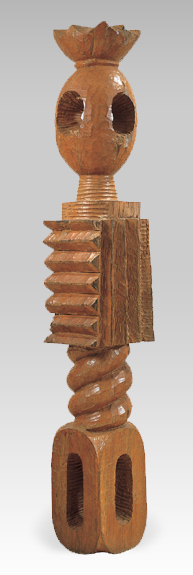|
|
The wooden works on view in the exhibition give a sense of how Brancusi peopled his imaginative world with powerful presences. He seems to have engaged more energetically and spontaneously with his wooden pieces than with stone, more readily allowing them to change in the process of production. This may reflect his sympathy for the (once) growing and previously functional material; many of these pieces were carved from reclaimed house-timbers, a history he made no attempt to disguise. The results are resolutely vertical, naturally recalling both a tree and a human at once. In Adam and Eve (1921), and especially in King of Kings (ca. 1938), the viewer is confronted with a totemic presence at once benign and mysteriously like a religious idol.
King of Kings was originally intended to stand in Brancusi's Temple of Meditation, a private sanctuary commissioned in 1933 by the Maharaja Yeshwant Rao Holkar of Indore. Although never realized, the temple—conceived as a windowless chamber (save for a ceiling aperture) with interior reflecting pool, frescoes of birds, and an underground entrance—would have embodied not just the idealization of aesthetic form but other concerns essential to Brancusi's art: the integration of architecture, sculpture, and furniture, and the poetic evocation of spiritual thought.
Contantin Brancusi, King of Kings, ca. 1938. Oak, 118 3/8 x 19 x 18 1/8 inches. Solomon R. Guggenheim Museum, New York 56.1449. © 2004 Artists Rights Society (ARS), New York/ADAGP, Paris.
|
|

